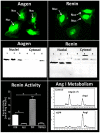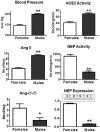Update on the Angiotensin converting enzyme 2-Angiotensin (1-7)-MAS receptor axis: fetal programing, sex differences, and intracellular pathways
- PMID: 24409169
- PMCID: PMC3886117
- DOI: 10.3389/fendo.2013.00201
Update on the Angiotensin converting enzyme 2-Angiotensin (1-7)-MAS receptor axis: fetal programing, sex differences, and intracellular pathways
Abstract
The renin-angiotensin-system (RAS) constitutes an important hormonal system in the physiological regulation of blood pressure. Indeed, dysregulation of the RAS may lead to the development of cardiovascular pathologies including kidney injury. Moreover, the blockade of this system by the inhibition of angiotensin converting enzyme (ACE) or antagonism of the angiotensin type 1 receptor (AT1R) constitutes an effective therapeutic regimen. It is now apparent with the identification of multiple components of the RAS that the system is comprised of different angiotensin peptides with diverse biological actions mediated by distinct receptor subtypes. The classic RAS can be defined as the ACE-Ang II-AT1R axis that promotes vasoconstriction, sodium retention, and other mechanisms to maintain blood pressure, as well as increased oxidative stress, fibrosis, cellular growth, and inflammation in pathological conditions. In contrast, the non-classical RAS composed of the ACE2-Ang-(1-7)-Mas receptor axis generally opposes the actions of a stimulated Ang II-AT1R axis through an increase in nitric oxide and prostaglandins and mediates vasodilation, natriuresis, diuresis, and oxidative stress. Thus, a reduced tone of the Ang-(1-7) system may contribute to these pathologies as well. Moreover, the non-classical RAS components may contribute to the effects of therapeutic blockade of the classical system to reduce blood pressure and attenuate various indices of renal injury. The review considers recent studies on the ACE2-Ang-(1-7)-Mas receptor axis regarding the precursor for Ang-(1-7), the intracellular expression and sex differences of this system, as well as an emerging role of the Ang1-(1-7) pathway in fetal programing events and cardiovascular dysfunction.
Keywords: ACE; ACE2; Ala1-Ang-(1–7); Ang-(1–7); Mas receptor; Mas-related receptor D; fetal programing.
Figures





Similar articles
-
Nonclassical renin-angiotensin system and renal function.Compr Physiol. 2012 Oct;2(4):2733-52. doi: 10.1002/cphy.c120002. Compr Physiol. 2012. PMID: 23720263 Free PMC article. Review.
-
Biochemical evaluation of the renin-angiotensin system: the good, bad, and absolute?Am J Physiol Heart Circ Physiol. 2016 Jan 15;310(2):H137-52. doi: 10.1152/ajpheart.00618.2015. Epub 2015 Oct 16. Am J Physiol Heart Circ Physiol. 2016. PMID: 26475588 Free PMC article. Review.
-
Physical Exercise and ACE2-Angiotensin-(1-7)-Mas Receptor Axis of the Renin Angiotensin System.Protein Pept Lett. 2017 Nov 17;24(9):809-816. doi: 10.2174/0929866524666170728151401. Protein Pept Lett. 2017. PMID: 28758593 Review.
-
ACE2 and vasoactive peptides: novel players in cardiovascular/renal remodeling and hypertension.Ther Adv Cardiovasc Dis. 2015 Aug;9(4):217-37. doi: 10.1177/1753944715597623. Epub 2015 Aug 13. Ther Adv Cardiovasc Dis. 2015. PMID: 26275770 Review.
-
Differential regulation of angiotensin converting enzyme 2 and nuclear factor-κB by angiotensin II receptor subtypes in type 2 diabetic kidney.Biochimie. 2015 Nov;118:71-81. doi: 10.1016/j.biochi.2015.08.005. Epub 2015 Aug 10. Biochimie. 2015. PMID: 26271886
Cited by
-
Exogenous Nucleotides Ameliorate Age-Related Decline in Testosterone in Male Senescence-Accelerated Mouse Prone-8 (SAMP8) Mice by Modulating the Local Renin-Angiotensin System Antioxidant Pathway.Nutrients. 2023 Dec 17;15(24):5130. doi: 10.3390/nu15245130. Nutrients. 2023. PMID: 38140389 Free PMC article.
-
Renal Vascular Response to Angiotensin II Administration in Two Kidneys-One Clip Hypertensive Rats Treated with High Dose of Estradiol: The Role of Mas Receptor.Int J Vasc Med. 2021 Mar 1;2021:6643485. doi: 10.1155/2021/6643485. eCollection 2021. Int J Vasc Med. 2021. PMID: 33747565 Free PMC article.
-
Role of angiotensin II in aging.Front Aging Neurosci. 2022 Dec 2;14:1002138. doi: 10.3389/fnagi.2022.1002138. eCollection 2022. Front Aging Neurosci. 2022. PMID: 36533172 Free PMC article. Review.
-
Vitamin D and COVID-19: An Overview of Recent Evidence.Int J Mol Sci. 2021 Sep 29;22(19):10559. doi: 10.3390/ijms221910559. Int J Mol Sci. 2021. PMID: 34638897 Free PMC article. Review.
-
Impact of sex and gender on COVID-19 outcomes in Europe.Biol Sex Differ. 2020 May 25;11(1):29. doi: 10.1186/s13293-020-00304-9. Biol Sex Differ. 2020. PMID: 32450906 Free PMC article. Review.
References
-
- Chappell MC, Brosnihan KB, Diz DI, Ferrario CM. Identification of angiotensin-(1-7) in rat brain: evidence for differential processing of angiotensin peptides. J Biol Chem (1989) 264:16518–23 - PubMed
-
- de Gasparo M, Catt KJ, Inagami T, Wright JW, Unger TH. The angiotensin II receptors. Pharmacol Rev (2000) 52:415–72 - PubMed
-
- Kambayashi Y, Bardhan S, Takahashi K, Tsuzuki S, Inui H, Hamakubo T, et al. Molecular cloning of a novel angiotensin II receptor isoform involved in phosphotyrosine phosphatase inhibition. J Biol Chem (1993) 268:24543–6 - PubMed
Publication types
Grants and funding
LinkOut - more resources
Full Text Sources
Other Literature Sources
Medical
Miscellaneous

